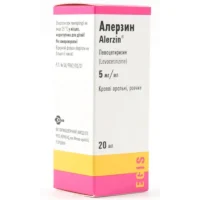Description
Erius (Desloratadine) Coated Tablets 5 mg. №10
Ingredients
Each tablet contains 5 mg of desloratadine.
Mechanism of Action
Desloratadine, the active ingredient in Erius tablets, acts as a potent and selective antagonist of histamine H1 receptors. By blocking these receptors, desloratadine effectively alleviates symptoms of allergic conditions such as sneezing, itching, and runny nose.
Pharmacological Properties
Erius tablets exhibit antihistaminic properties by inhibiting the action of histamine on H1 receptors, thereby reducing allergic symptoms.
Indications for Use
Erius tablets are indicated for the relief of symptoms associated with allergic rhinitis (hay fever) and chronic idiopathic urticaria (hives).
Contraindications
Avoid using Erius if you have a known allergy to desloratadine or any other components present in the tablets.
Side Effects
Common side effects of Erius may include drowsiness, headache, and dry mouth. In rare cases, allergic reactions or liver problems may occur. Consult a healthcare professional if any adverse effects are experienced.
Usage Instructions
The recommended dosage for adults and children over 12 years old is one tablet once daily. Swallow the tablet whole with water; do not chew or crush it.
Benefits Compared to Analogues
Erius offers rapid and long-lasting relief from allergy symptoms with minimal sedative effects, distinguishing it as a preferred choice for many patients over other antihistamines.
Suitable Patient Groups
Erius is suitable for adults and children over 12 years old. Caution should be exercised in elderly patients and individuals with liver or kidney problems; dosage adjustments may be necessary in such cases.
Storage Conditions and Shelf Life
Store Erius tablets in a cool, dry place away from direct sunlight. Check the expiration date on the packaging and do not use the tablets beyond that date.
Packaging Description
Erius tablets are supplied in a package containing 10 coated tablets, each with a desloratadine dosage of 5 mg.
Clinical Evidence and Proven Effectiveness
Clinical studies have shown that desloratadine in Erius tablets effectively alleviates symptoms of allergic rhinitis and chronic idiopathic urticaria. The medication provides rapid relief with minimal sedative effects, making it a reliable choice for managing allergic conditions.





